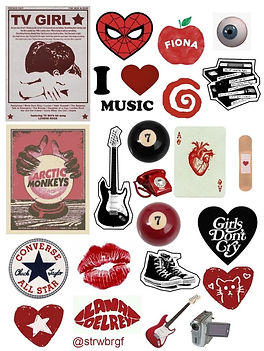Shooting a Short Film
Next, I tried to level up the game and shoot a short film as practice for my final film opening. I wanted to create something within the confines of our selected genre, Coming-of-Age.
One of my favorite movies in this genre is The Breakfast Club which is a film I actually discovered through the Cartoon Network show, "Teen Titans Go!" Episode seven of season three, "Hey You, Don't Forget about Me in Your Memory", aired on Cartoon Network in 2015. It was one of my favorite episodes of the show for years and I still go back to it sometimes. After a couple years of watching the show, I realized it is laden with intertextuality and references to other shows and I started Googling and researching episodes I had watched which eventually led me down a rabbit hole to the 1985 American indie teen coming-of-age comedy-drama film. This film ending up being my main source of inspiration for my short film.
For casting, I asked around campus if anyone was willing to be in the project since it comprised of only a few shots and would be finished rather quickly. Having gathered a handful of volunteers, we began shooting.
In terms of equipment, I used my iPhone 13 Pro Max in Cinematic mode alongside Capcut as my editing software as it had a range of built-in effects in the expansive effects library I wanted to use in my film to make it compelling and engaging.
The plot essentially revolves around a Butterfly Effect caused by the protagonist's stickers falling on the ground which get picked up by students around campus leading to new connections and friendships being formed.
For props, I drew and cut out stickers and bright colors matching the vibrant mood and eclectic color grading I planned to do in post-production.
The main inspiration drawn from The Breakfast Club was in the film's themes, soundtrack and a homage to its ending.
The film handles themes of connection, friendship and identity in a powerful way. The enforced isolation of detention becomes an unlikely crucible where the characters shed their stereotypical facades and forge genuine connections. They discover shared experiences and frustrations that transcend their social labels, leading to a sense of belonging and identity that they weren't expecting. These themes were a large source of inspiration for my film's narrative which I portrayed through aspects such as the plot, mise-en-scene, editing and more.
"Don't You (Forget About Me)" by Simple Minds has become synonymous for The Breakfast Club thus I used it as my primary audio. This song is a quintessential 80s anthem that perfectly captures the bittersweet emotions of teen friendship. The energetic synth melody and Jim Kerr's powerful vocals build a sense of longing and defiance hence being a good choice. This song adds another layer to these themes by capturing the fear of losing these newfound friendships. It highlights the uncertainty teenagers face as they navigate the complexities of identity and belonging.
I aimed for a silent film without dialogue (mainly due to a lack of good sound conditions and there being a lot of noise around).



"Don't You (Forget About Me)" by Simple Minds has become synonymous for The Breakfast Club thus I used it as my primary audio. This song is a quintessential 80s anthem that perfectly captures the bittersweet emotions of teen friendship. The energetic synth melody and Jim Kerr's powerful vocals build a sense of longing and defiance hence being a good choice. This song adds another layer to these themes by capturing the fear of losing these newfound friendships. It highlights the uncertainty teenagers face as they navigate the complexities of identity and belonging.
I aimed for a silent film without dialogue (mainly due to a lack of good sound conditions and there being a lot of noise around).
The Breakfast Club explores themes of connection, identity, and overcoming stereotypes. The final shot of the film lingers on Bender, the rebel, walking alone across a football field. This image is rich with meaning, suggesting Bender may break free from social pressures, highlights his personal growth, and shows a newfound confidence. The ending is hopeful but acknowledges the uncertainty of the friendships forged in detention.
This shot serves as a point for the audience to ponder over the events of the film and its message. Through my homage to this shot, I recreated similar emotions for my film's audience to ponder over the Butterfly Effect and how it contributed to the narrative by prompting reflection on the power of connection.
Reflecting upon the final product, I think I